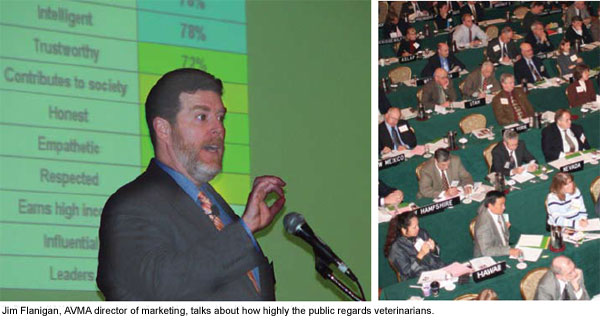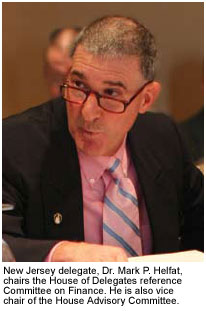AVMA conference draws veterinary leaders to Windy City

With some 430 attendees, the 2007 annual AVMA Veterinary Leadership Conference was the highest attended VLC to date. Held Jan. 5-7 in Chicago, the meeting was divided into an Informational Assembly and Special Session for the AVMA House of Delegates, and a leadership development program.
Future value
The intersection of veterinary economics and the general public's adoration of the veterinary profession was the focus of the 2007 AVMA Veterinary Leadership Conference's opening session for all attendees.
Presenter Jim Flanigan, AVMA director of marketing, centered on three issues: how the attitudes of veterinarians are likely to change veterinary economics, the attitudes of animal owners about the provision of veterinary services, and how the public perceives veterinarians and their value to society.
"What you have at the intersection of those three issues is, hopefully, some real insight that leaders of the profession can take and decide on the future of the veterinary profession," Flanigan said.
Flanigan referred to the recently completed AVMA Public Perceptions Survey during his talk. The research provided a benchmark against which future AVMA efforts to educate the public can be measured.
When asked how they perceived veterinarian treatment of pets, 67 percent of respondents said as well as their physician treats them while 26 percent said better than their physician treats them. The primary drivers behind the public's overall satisfaction with the profession are confidence in the veterinarian's medical skills and the friendliness of the veterinarian.
Flanigan said the relationship between veterinary practitioners and their clients is the most powerful tool veterinarians have to maintain or advance the public's perception of the veterinarian's value to society, and to help the public understand the entire range and diversity of veterinarians' roles.
From the Association
AVMA President Roger K. Mahr noted that when veterinarians take the professional oath, they pledge to use their scientific skills and knowledge for the betterment of society. "In my mind, no other profession has a comparable value to society. Certainly, no other profession has the impact on both animal and human health," he said.
Dr. Mahr believes that animal health is at a crossroads, and its convergence with human health and ecosystem health requires embracing a "one-world, one-health, one-medicine concept." Collaborating and cooperating with veterinary medicine's counterparts in human medicine, public health, and environmental sciences is imperative, he added.
"Together, we can accomplish more in the areas of improving animal and human health worldwide than we can alone," Dr. Mahr explained. "And we as the veterinary profession have the responsibility to take a major leadership role in that effort."
President Mahr told attendees he remains committed to his one-medicine vision, and, as previously stated in the Jan. 1, 2007 JAVMA News, he will be introducing a recommendation for implementing his plan at the April Executive Board meeting.
Dr. Mahr also announced that Julie Gerberding, MD, director of the Centers for Disease Control and Prevention, will be the keynote speaker at the AVMA Annual Convention in Washington, D.C., this July.
AVMA Treasurer Bret D. Marsh told conferees that the 2007 budget is $27.5 million—the largest in AVMA history. He predicted "another great AVMA convention" in Washington, D.C., this summer; noted that there are 138 approved AVMA staff positions at AVMA headquarters and in the capital, 19 of them currently vacant; and that the 2008 budget development process is already under way.
Dr. Merry Crimi, delegate for the American Animal Hospital Association, and a panel of AVMA staff discussed strategic planning goals for five issues approved by the Executive Board as critically important to the future of veterinary medicine. Those issues are animal welfare, veterinary workforce, economic viability, veterinary education, and veterinary services.
The Executive Board established a strategic planning committee, currently chaired by Dr. Crimi, to identify key issues and coordinate an effective planning process. Dr. Crimi began the presentation by asking, "Where in the world do we at AVMA want to go?" She and the panel of AVMA staff then reported on current activities for selected goals the AVMA is to achieve for each critical issue in the years ahead.
Under animal welfare, for instance, the AVMA is to work toward a uniform definition of the legal status of animals in all states consistent with AVMA policy. One of the goals for economic viability is securing adequate government and/or private funding for critical veterinary research. Dr. Crimi asked for delegates' input to help the committee and Executive Board prioritize the strategic planning goals.
Following the presentation, Dr. James O. Cook, Executive Board chair, encouraged delegates to elect him 2007-2008 AVMA president-elect when the HOD convenes this July in Washington, D.C. Dr. Cook is the only declared candidate for the position. In addition, AVMA Vice President Charles M. Hendrix asked delegates to vote him in for a second term in office. He, too, is the only candidate.
House actions
The House of Delegates Special Session that was convened Jan. 6 by the House Advisory Committee chair, Dr. Michael Whitehair, was the first in recent memory. The decision to hold a Special Session was made by the HOD at its 2006 annual session, July 15 in Honolulu, after it approved the Amended and Restated AVMA Bylaws. The HOD had approved a request from Dr. John de Jong, then HAC chair, to hold the Special Session during the January leadership conference. Dr. de Jong said the purpose would be to review and approve a revised House of Delegates Manual, discuss potential amendments to the new bylaws, and discuss procedures for future bylaws amendments.
At the Special Session, delegates adopted the proposed revised House of Delegates Manual as presented, including the proviso that the addendum concerning information on the AVMA councils will remain a part of the manual until the HOD approves an amendment to include that information in the AVMA Bylaws. Information about all but two of the concerns had been removed from the AVMA Constitution and Bylaws during the transition to the new Bylaws.

The revised HOD manual incorporates changes that ensure conformance with the newly adopted Bylaws and the uniformity of all AVMA governing documents. Also, the manual was reorganized to emphasize the HOD's duties throughout the year, not only at its annual session.
Besides procedural changes, some substantive changes took effect with the new HOD manual. For example, the House can now make changes that go beyond minor editing of a resolution, a provision that is supported by parliamentary procedure. Florida's alternate delegate, Dr. Larry Dee, said, "I think this greatly enhances the ability of the House to function."
Following the Special Session, the annual HOD Informational Assembly was convened. Delegates raised issues that included whether AVMA member petitions should continue to be one process by which resolutions can be submitted to the HOD, and if so, whether sponsorship by an entity represented in the HOD should be required; whether the HOD should undertake its own strategic planning; and whether to return to a system in which the HOD Annual Session does not overlap with the AVMA Annual Convention.
No formal actions are taken during the HOD Informational Assembly. This July, however, the HOD will vote on a proposed amendment to the AVMA Bylaws that would authorize the HOD to hold a "regular winter session in conjunction with the AVMA Veterinary Leadership Conference."
Diversity and the veterinary profession
While the HOD met, other attendees participated in five leadership development workshops, including a new one on diversity. Brian Sorge, vice president of Client Solutions, Lambert & Associates Inc., presented three sessions—on diversity and the practice of veterinary medicine; gender and generational differences; and race, ethnicity, and cultural differences.
About generational differences, Sorge said, "There is going to be a labor shortage of professionals and technicians that we've never seen. Headhunters are ramping up their staffing. Generational differences are becoming more of a factor (in the workplace)." An awareness of these differences—such as personal time being a strong motivator for recent graduates—is valuable from a practice management standpoint.
The keynote presentation was on context, conceptualization, and considerations for managing the transition in gender composition. The presenters were Martin Heesacker, PhD, professor and chair of the Department of Psychology, University of Florida, and assistant professor Bonnie Moradi, PhD. They discussed the view of veterinary medicine as part of a broader societal change away from a male-dominated field, presented relevant gender research, and debunked some myths about why there are wage inequities between males and females. One of the factors that may contribute to wage inequities is consumer bias, Dr. Moradi noted.
Dr. Heesacker said, "Because veterinary school students are increasingly female, occupational segregation in veterinary medicine overall is being reduced. However, very few women are in large animal veterinary care." He added, "Our anecdotal sense is that more men than women are in top leadership positions."
He offered considerations to help veterinarians manage the gender transition. To reduce intergender conflict, for example, he advises correcting gender-based inequities, segregation, and misperceptions along with unconscious stereotypes, and increasing the focus on individual and context differences rather than gender differences.
"What we see on the horizon is a huge transition of veterinary practices," Dr. Heesacker said. "We have many senior males who own practices, and they are nearing the end of their careers, and increasingly, those practices are going to be sold to female, younger veterinarians." Both those groups need the knowledge, skills, and abilities to understand the right, fair, and effective way to buy, sell, and manage a practice, he said.
Other considerations involve mentoring, dispelling gender misperceptions by the public, making veterinary wage information public, and publicizing characteristics that veterinary schools look for in students, that veterinary practice owners look for in veterinary associates, and that associates look for in practice owners.